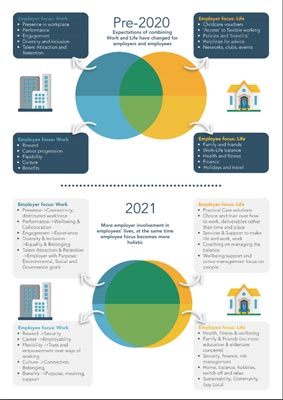The rise of ‘Big Employer’

Author: Jennifer Liston-Smith, Head of Thought Leadership
Now in 2021, the role of the employer in our employees’ lives has expanded. As we responded to the waves of pandemic across 2020, it became clear – in the UK and elsewhere – that a certain level of ‘Big Government’ would be needed to steer a course. We nodded through centralised rules and looked to the Chancellor to find much-needed funds to support business and society.
In a similar way, we’ve seen the rise of what we could call ‘Big Employer’. Many people’s jobs moved into their homes and a new intimacy was created at the click of a mouse. New, more direct dialogues also sprang up about righting racial injustice and generating a sense of belonging; and employers felt more responsible than ever for wellbeing and mental health.
In Practical Terms
Within our client relationships, we noticed employers stepping up in these ways:
- The increasing commitment of employers to practical care solutions: more on this below
- An expansion of person to person virtual coaching programmes to empower the work-life blend – both with external experts and internal buddies
- Recognising the value of networks and employee resource groups with more events than ever on themes of wellbeing, mental health, resilience, remote working and similar topics for parents, carers and for all.
- A huge appetite for 24/7 online information, articles and signposting on family life and wellbeing: most employers have wanted to provide some variation of a ‘Covid-hub’.
On the practical care front, one of the most compelling impressions, according to our Director of Work + Family Operations, Venetia Leigh, is that the use and purpose of backup care is expanding. What was previously seen as a fall-back ‘last-minute’ care provision continues to be a way of enabling people to be present for work, yet in 2020, it also moved further towards being viewed as an holistic resource. Like many employer programmes, the driver has become more about support, about making life easier.
In practical terms, last year this meant employers increasing the number of available days of care for employees or lifting limits on when it might be used (whether during traditional working hours or otherwise) or how far ahead it can be booked. Employers who wanted to provide onsite nursery care to employees also expanded their vision, securing spaces for employees in nurseries closer to home: 2020’s top ‘workplace’ for so many dedicated working parents and others.
Emerging Trends
Everywhere, employers innovated. Life and work blended; and for many, this also prompted a rethink or reset. In the ongoing research carried out by our friends at Accenture, it emerged that 95% of individuals, among several thousand global responses, decided as a result of COVID, to make at least one lasting change in how they live, shop or work. There was an emerging emphasis on purpose, sustainability, buying or sourcing locally, cutting back, looking after health, and the importance of family.
Meanwhile, Citrix looked ahead to Work 2035 with a study of workers across Europe and the US, combined with opinions from thought leaders. Here, the interplay of the sudden shift to new ways of working, coupled with technology – and specifically Artificial Intelligence – point to four potential scenarios. These futures pivot round two key axes: whether organisations will be centralised or dispersed and whether workers will be replaced or augmented by technology.
Most business leaders consulted anticipate a ‘world of strong corporate structures fuelled by a flourishing partnership between people and technology’, while most employees foresaw more dispersed ways of working, with many roles replaced by tech. The choices we will face (or make unconsciously) about how best to have technology augment human capability are not to be overlooked. However, as we enter 2021, it has become clear that many employers will go to great lengths to support and enable their human workforce. That very humanity is front and centre.
Putting it into Pictures, and Action
With the growth of employer involvement in practical support and mental health, can we say that the domains of work and life have drawn closer together? Is there now more of an overlap? Are the topics for discussion with employers more all-encompassing? If so, then perhaps it looks a little like the diagram here.
Thinking about these changes can guide our actions as employers as we recognise that life and work have overlapped and are set to remain intertwined for most of our workforces.
A New Year’s resolution? Commit to supporting the two domains in more practical and concrete ways, while also understanding that employees want to regain a sense of control over both.






